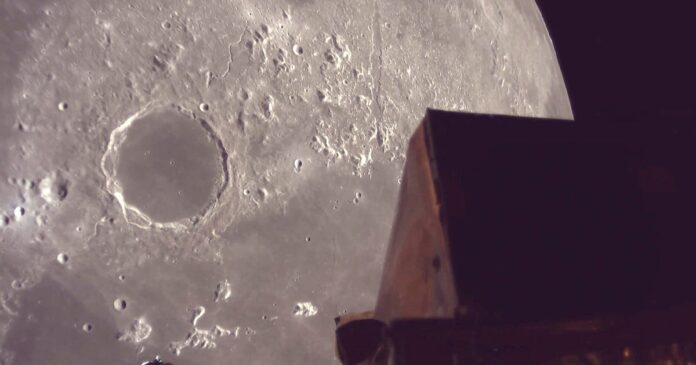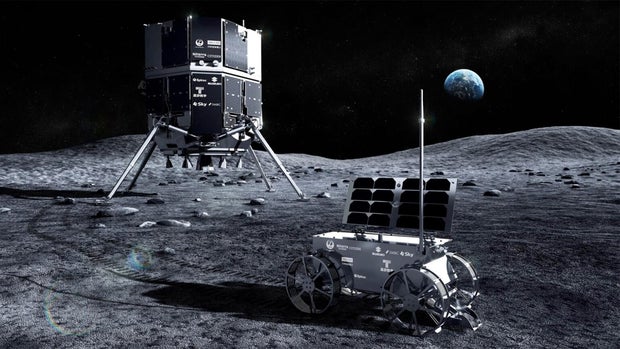A privately-built Japanese moon lander made its descent to touchdown on the lunar surface Thursday, but has so far failed to send a signal back to Earth as controllers anxiously awaited data to confirm if the landing was a success. The latest mission comes two years after the company’s first lander ran out of gas and crashed to the lunar surface.
The Resilience lander, carrying cameras, a few scientific instruments and a tiny rover, was scheduled to drop out of a 62-mile-high orbit and touch down at 3:17 p.m. EDT near the center of Mare Frigoris — the Sea of Cold — in the moon’s northern hemisphere at 60 degrees north latitude.
The company ended its livestream coverage of the landing about 15 minutes later, saying team members were continuing their attempts to communicate with the lander.
ispace, inc. via AP
“For Mission 2, our second attempt at landing on the moon, we will not only land the Resilience lander, but we will also use a mechanism to deploy the Tenacious rover, which we developed in house, to explore the lunar surface,” Ryo Ujiie, chief technology officer of ispace, the lander’s builder, said on the company’s web page.
“Tenacious will explore the lunar surface, deploy a customer payload and collect regolith. Resilience will continue to operate the customer payloads on board and transmit valuable telemetry data to our mission control center.”
The customer payload is a tiny model of a Swedish house, designed by artist Mikael Genberg. The traditionally styled red-and-white house measures just 4.7 inches long and 4 inches high and weighs just 3.5 ounces.
iSpace
Asked why he took on the project, which required years of planning, fund-raising and engineering, Genberg said “we have done as human beings things from time to time that (do not) seemingly have a purpose beyond just being creative.”
“The Eiffel Tower, for instance, I mean it’s a stupid thing to build,” he said. “Today, it has a purpose as maybe the most important thing to make Paris the most visited city in the world.”
While the “moonhouse” could survive for thousands if not millions of years in the airless environment of the moon, its custom paint will fade in the sun’s harsh radiation and lunar dust will slowly coat its surface. Genberg joked that he would happily await an invitation to repaint it.
The house would be dropped from the rover a few days after landing, and the team hopes to capture photos with Earth in the background. The cost of the project was not disclosed, but a spokesman said it was similar to what one might pay for a relatively large house on Earth.
ispace
ispace is one of a handful of companies attempting to provide non-government transportation services to the moon for a variety of payloads ranging from science instruments to technology demonstrations.
But as it turns out, getting low-cost spacecraft to the moon’s surface is extremely difficult.
ispace tried and failed in 2023 when its first lander ran out of propellant nearing the surface, dropping to a “hard” crash landing. Pittsburgh-based Astrobotic Technology launched its Peregrine lander in January 2024, but the spacecraft suffered a propulsion system leak and never made it to the moon.
Houston-based Intuitive Machines successfully put two landers down on the lunar surface in 2024 and again earlier this year, but both spacecraft tipped over on touchdown. While each one survived its landing, neither was able to accomplish all of its pre-flight objectives.
Before Thursday, only one company, Austin-based Firefly Aerospace, had successfully touched down and carried out its mission, landing the Blue Ghost spacecraft on March 2, 53 years after the final Apollo mission.
Resilience and Blue Ghost were launched atop a single SpaceX Falcon 9 rocket on Jan. 15. The Blue Ghost lander took a direct route to the moon and carried out a successful touchdown, operating for a full two-week lunar “day.”
Resilience followed a longer, low-energy trajectory that carried it well past its target, using the moon’s gravity to bring it back to an initially elliptical orbit and finally, using its thrusters, to the 100-kilometer (62-mile) circular orbit that set the stage for descent.


